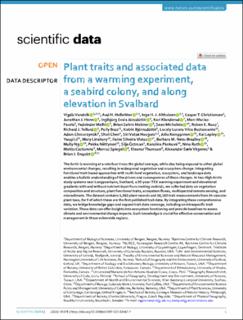| dc.contributor.author | Vandvik, Vigdis | |
| dc.contributor.author | Halbritter, Aud Helen | |
| dc.contributor.author | Althuizen, Inge | |
| dc.contributor.author | Christiansen, Casper Tai | |
| dc.contributor.author | Henn, Jonathan Jeffrey | |
| dc.contributor.author | Jonsdottir, Ingibjorg Svala | |
| dc.contributor.author | Klanderud, Kari | |
| dc.contributor.author | Macias-Fauria, Marc | |
| dc.contributor.author | Malhi, Yadvinder | |
| dc.contributor.author | Maitner, Brian Salvin | |
| dc.contributor.author | Michaletz, Sean T. | |
| dc.contributor.author | Roos, Ruben Erik | |
| dc.contributor.author | Telford, Richard James | |
| dc.contributor.author | Bass, Polly | |
| dc.contributor.author | Björnsdóttir, Katrin | |
| dc.contributor.author | Bustamante, Lucely Lucero Vilca | |
| dc.contributor.author | Chmurzynski, Adam | |
| dc.contributor.author | Chen, Shuli | |
| dc.contributor.author | Haugum, Siri Vatsø | |
| dc.contributor.author | Kemppinen, Julia | |
| dc.contributor.author | Lepley, Kai | |
| dc.contributor.author | Li, Yaoqi | |
| dc.contributor.author | Linabury, Mary | |
| dc.contributor.author | Matos, Ilaine Silveira | |
| dc.contributor.author | Neto-Bradley, Barbara M. | |
| dc.contributor.author | Ng, Molly | |
| dc.contributor.author | Niittynen, Pekka | |
| dc.contributor.author | Hjortland Östman, Silje Andrea | |
| dc.contributor.author | Pankova, Karolina | |
| dc.contributor.author | Roth, Nina | |
| dc.contributor.author | Castorena, Matiss | |
| dc.contributor.author | Spiegel, Marcus P. | |
| dc.contributor.author | Thomson, Eleanor R. | |
| dc.contributor.author | Vågenes, Alexander Sæle | |
| dc.contributor.author | Enquist, Brian J. | |
| dc.date.accessioned | 2023-12-08T07:43:09Z | |
| dc.date.available | 2023-12-08T07:43:09Z | |
| dc.date.created | 2023-11-24T17:50:41Z | |
| dc.date.issued | 2023 | |
| dc.identifier.citation | Scientific Data. 2023, 10 . | |
| dc.identifier.issn | 2052-4463 | |
| dc.identifier.uri | https://hdl.handle.net/11250/3106533 | |
| dc.description.abstract | The Arctic is warming at a rate four times the global average, while also being exposed to other global environmental changes, resulting in widespread vegetation and ecosystem change. Integrating functional trait-based approaches with multi-level vegetation, ecosystem, and landscape data enables a holistic understanding of the drivers and consequences of these changes. In two High Arctic study systems near Longyearbyen, Svalbard, a 20-year ITEX warming experiment and elevational gradients with and without nutrient input from nesting seabirds, we collected data on vegetation composition and structure, plant functional traits, ecosystem fluxes, multispectral remote sensing, and microclimate. The dataset contains 1,962 plant records and 16,160 trait measurements from 34 vascular plant taxa, for 9 of which these are the first published trait data. By integrating these comprehensive data, we bridge knowledge gaps and expand trait data coverage, including on intraspecific trait variation. These data can offer insights into ecosystem functioning and provide baselines to assess climate and environmental change impacts. Such knowledge is crucial for effective conservation and management in these vulnerable regions. | |
| dc.language.iso | eng | |
| dc.title | Plant traits and associated data from a warming experiment, a seabird colony, and along elevation in Svalbard | |
| dc.title.alternative | Plant traits and associated data from a warming experiment, a seabird colony, and along elevation in Svalbard | |
| dc.type | Peer reviewed | |
| dc.type | Journal article | |
| dc.description.version | publishedVersion | |
| dc.source.pagenumber | 21 | |
| dc.source.volume | 10 | |
| dc.source.journal | Scientific Data | |
| dc.identifier.doi | 10.1038/s41597-023-02467-7 | |
| dc.identifier.cristin | 2202075 | |
| dc.relation.project | Norges forskningsråd: 287784 | |
| cristin.ispublished | true | |
| cristin.fulltext | original | |
| cristin.qualitycode | 1 | |
